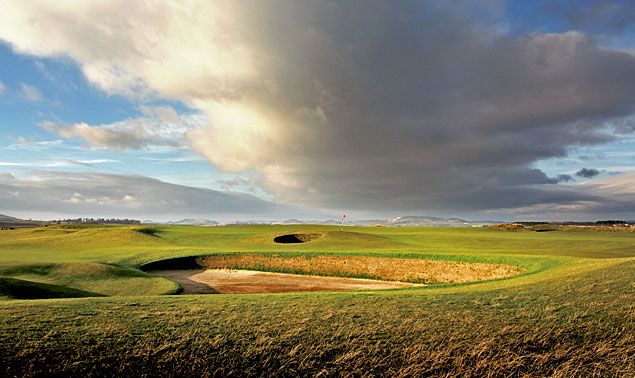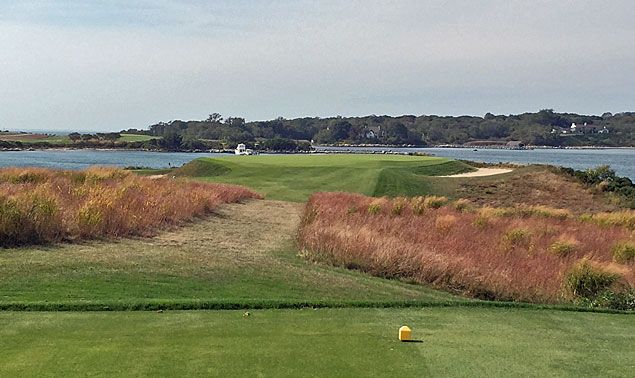E is for EDEN
THE ORIGINAL
The “Eden” is one of several templates finding its origins at the Home of Golf itself, the Old course at St. Andrews. It’s a decent hike from the Royal and Ancient, as No. 11 “High In”—the original Eden—is the farthest hole from the clubhouse.

St Andrews Old course 11th hole - image courtesy of Kevin Murray
We derive the template’s name from the River Eden, which becomes an estuary while meeting the North Sea just behind the iconic short hole. Many golfers will consider the green a relative “Garden of Eden” after the challenges that must be overcome to enter. There are very few casual shots, even for those who get home in one, however. The trouble ends with the green itself, severely slanted from back to front. At 175 yards, the challenge is accuracy with one’s middle irons. Hitting past the pin brings the distinct possibility of putting off the green... or worse.
Traditional Edens feature four distinct hazards, usually bunkers, all named for posterity. The first is the “Cockleshell” or “Shelly” bunker. This is placed well forward of the green, and should only be found by a poor tee shot. The “Hill” bunker sits greenside-left, and is of significant depth. Getting up-and-down onto the slanting green is hardly guaranteed. Perhaps the most significant bunker is also the smallest: The “Strath” (taking its name from a legendary golf gambler of lore) is a pot bunker sitting right in front of the green. The greatest humiliation is putting from the back of the green into the bunker, pitching out, and repeating the process. Finally, the “Eden” is not a bunker at all in the Old course’s case, but rather a valley behind the green going down to the river. Hitting up and trying to hold the green on the way down... this too is a damnable shot.
OTHER INTERPRETATIONS
The Eden is often cited as second only to the Redan in terms of conceptual strength, so of course C.B. Macdonald included one at the National Golf Links of America. On one hand, Macdonald realized the cruelty of the original Eden, so he made the slopes considerably more gracious here. On the other hand, he also greatly expanded the size of the green to make up for this generosity, leaving more lengthy (if gentler) putts. Some have complained that a layer of rough prevents some quick putts from reaching the Old course’s Strath. Those gluttons for punishment will be rewarded here: all short grass from the green into the pit. The “Eden” hazard becomes a bunker at NGLA, a moat-like trench that runs from front-right and around the back of the entire green.
It’s also worth noting that Macdonald’s most prominent Eden plays across a pond, although not long enough to rattle any but the most anxious golfers. This trend would continue down the line to Macdonald’s followers, Seth Raynor and Charles Banks, who also included ponds or other forced carries from the tee at their own Edens. Neither Raynor nor Banks ever had the opportunity to visit St. Andrews, which may explain the variance in designs. One such case is at the Camargo Golf Club, where the green plays much like a Redan. The Hill Bunker is signature Raynor, nearly 30 feet deep. There are also renditions of the Strath and Eden bunkers, but no Shelly in play.

Camargo Club 5th hole - image courtesy of John Sabino
Tom Doak took a similar stance at Old Macdonald—Bandon’s tribute to the Father of American Golf Architecture—at least in terms of abandoning the Shelly bunker. The gap Doak allows between the Hill and Strath bunkers is significant, seemingly leaving the room open for a ground attack. This approach requires significant prayer as well: All the undulation along the fairway means luck is almost as important as skill if you plan to putt in regulation. One bad bounce, and a bunker beckons.

Old Macdonald 2nd hole - image courtesy of Bandon Dunes
Shinnecock Hills features a clever alternate take on the Eden, and indeed emerged during Macdonald’s renovation of the course during 1901. The deceptive nature of the template comes from the green’s unconventional tilt to the left in relation to the tee, unlike the conventional head-on nature of most Edens. The three consecutive bunkers to the left are more than just “three consecutive bunkers,” however. A well-struck shot should not find the first—the Shelly. The second, at the foot of the green, stands to collect poor putts—a Strath. The third is the Hill, direct left of the green. The larger Eden bunker sits at the back right.

Shinnecock Hills 17th hole - image courtesy of the USGA
MAYBE...MAYBE NOT
All of Raynor’s holes merit citation due to his closeness with Macdonald, but we must question the “Eden” status of his entry at Fishers Island. We’ve established that no hole requires all four prescribed Eden hazards, as even the original Eden did not feature a back bunker, and many Edens forgo the Shelly. We feel, however, there is an obligation to feature a Strath. The hole at Fishers Island is a tad short for the traditional Eden, but the green does slant to match the description. It only features two of the established bunkers, a Hill that forms a sand moat around the entire left side, and an Eden that forms a similar trap around the right. This hole may be too long to be a true “Short” template, but it’s one thumbprint from being synonymous with the infinity-views of Sleepy Hollow’s famed No. 16.

Fishers Island 11th hole - image courtesy of David Davis
As discussed, Raynor and Banks took some liberal interpretations of the concept, one case being Banks’s No. 17 at Knoll Golf Club West. The Eden Bunker serves both its purpose and Hill’s, as it wraps from front-left all the way around the bunker to the opposite side. The trouble in nailing down the “Eden” concept lies in the other three bunkers. The alleged “Hill” is now at the front of the green. One would need to be playing like Gary Woodland from the back of the green—i.e. chipping—to end up in the so-called “Strath.”
Although Eden is among the most revered templates, it’s worth noting several cases where Edens have not appeared. One is Harry Colt’s Eden course at St. Andrews itself. Although the course neighbors the Old course, features several holes along the Eden, and was built during the same period as Macdonald’s spirited promotion of templates, the Eden course itself does not feature the river’s namesake hole. Surely the Eden course at Fanling in Hong Kong is named for the river at St. Andrews, however no Eden hole exists. Notably, it does have a “Narrows” (as well as other charming hole titles such as “Devil’s Elbow” and “The Pimple”).
